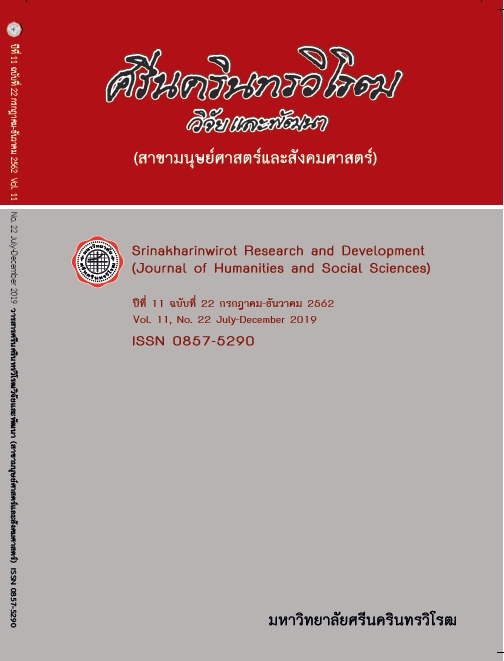ผลการจัดการเรียนรู้วิทยาศาสตร์สะเต็มศึกษากับการแก้ปัญหาโดยใช้รูปแบบกิจกรรม 4 WP สำหรับนักเรียนชั้นมัธยมศึกษาปีที่ 3 โรงเรียนสาธิตมหาวิทยาลัยศรีนครินทรวิโรฒ ปทุมวัน (STEM LEARNING APPROACH AND PROBLEM SOLVING USING THE 4WP FORMAT FOR MATHAYOMSUKSA III ST)
คำสำคัญ:
สะเต็มศึกษา, รูปแบบกิจกรรม 4 WPบทคัดย่อ
การวิจัยนี้มีวัตถุประสงค์เพื่อศึกษาผลการจัดการเรียนรู้วิทยาศาสตร์สะเต็มศึกษากับการแก้ปัญหาโดยใช้รูปแบบกิจกรรม 4 WP สำหรับนักเรียนชั้นมัธยมศึกษาปีที่ 3 โรงเรียนสาธิตมหาวิทยาลัยศรีนครินทรวิโรฒ ปทุมวัน กลุ่มตัวอย่างเป็นนักเรียนชั้นมัธยมศึกษาปีที่ 3 ปีการศึกษา 2560 จำนวน 49 คน จากนักเรียนทั้งหมด 402 คน ที่ได้มาจากการเลือกแบบเจาะจง เครื่องมือที่ใช้ในการวิจัยคือกิจกรรมวิทยาศาสตร์สะเต็มศึกษากับการแก้ปัญหาโดยใช้รูปแบบกิจกรรม 4 WP มีทั้งหมด 5 กิจกรรม ดำเนินการสอนโดยใช้เวลา 12 สัปดาห์ สัปดาห์ละ 2 คาบ ทั้งหมด 24 คาบ คาบละ 50 นาที สถิติที่ใช้ในการวิเคราะห์ข้อมูล คือ ค่าร้อยละ ค่าเฉลี่ย ส่วนเบี่ยงเบนมาตรฐาน และการทดสอบค่าที
ผลการวิจัยพบว่า
- 1. กิจกรรมวิทยาศาสตร์สะเต็มศึกษากับการแก้ปัญหาโดยใช้รูปแบบกิจกรรม 4 WP มีประสิทธิภาพ 76.04/73.21 ซึ่งเป็นไปตามเกณฑ์ 70/70 เมื่อพิจารณาค่าร้อยละของคะแนนเฉลี่ยจากคะแนนทดสอบระหว่างเรียนในแต่ละกิจกรรม พบว่ากิจกรรมที่ 1 กิจกรรม Spaghetti Bridge กิจกรรมที่ 2 กิจกรรมไข่ไก่ตกไม่แตก กิจกรรมที่ 3 กิจกรรมหอคอยไม้เสียบลูกชิ้น กิจกรรมที่ 4 กิจกรรมรถไฟรางกระดาษ และกิจกรรมที่ 5 กิจกรรม Spaghetti Tower มีค่าร้อยละของคะแนนเฉลี่ย 70.92, 82.86, 75.92, 86.53 และ 70.00 ตามลำดับ
- 2. ผลสัมฤทธิ์ทางการเรียนหลังเรียนกิจกรรมวิทยาศาสตร์สะเต็มศึกษากับการแก้ปัญหาโดยใช้รูปแบบกิจกรรม 4 WP ของนักเรียนชั้นมัธยมศึกษาปีที่ 3 คิดเป็นร้อยละ 73.21 สูงกว่าเกณฑ์ร้อยละ 70 อย่างมีนัยสำคัญทางสถิติที่ระดับ .05
- 3. ผลการประเมินพฤติกรรมการทำงานกลุ่มหลังเรียนกิจกรรมวิทยาศาสตร์สะเต็มศึกษากับการแก้ปัญหาโดยใช้รูปแบบกิจกรรม 4 WP พบว่าพฤติกรรมการทำงานกลุ่มหลังเรียนกิจกรรม Spaghetti Bridge และกิจกรรมไข่ไก่ตกไม่แตก ผลการประเมินอยู่ในระดับดี ส่วนพฤติกรรมการทำงานกลุ่มหลังเรียนกิจกรรมหอคอยไม้เสียบลูกชิ้น
และกิจกรรมรถไฟรางกระดาษ ผลการประเมินอยู่ในระดับดีมาก
Downloads
References
[2] สำนักนายกรัฐมนตรี. (2553). พระราชบัญญัติการศึกษาแห่งชาติ พ.ศ. 2542 แก้ไขเพิ่มเติม (ฉบับที่ 2) พ.ศ. 2545 และ (ฉบับที่ 3) พ.ศ. 2553. สืบค้นจาก https://www.mwit.ac.th/~person/01-Statutes/NationalEducation.pdf
[3] Robbins. P Stephen. (2001). Organization Behavior. 9th ed. New Jersey: Prentice–Hall.
[4] มนตรี จุฬาวัฒนฑล. (2557). การศึกษาวิทยาศาสตร์ เทคโนโลยี วิศวกรรมและคณิตศาสตร์ หรือ “สะเต็มศึกษา”. สมาคมครูวิทยาศาสตร์ คณิตศาสตร์ และเทคโนโลยี. 41(182), 15-16.
[5] คณาภรณ์ รัศมีมารีย์, และคณะ. (2560). การนำเสนอรูปแบบการจัดกิจกรรมเพื่อส่งเสริมค่านิยมหลักของคนไทย 12 ประการ ของนักเรียนโรงเรียนสาธิตสังกัดสำนักงานคณะกรรมการการอุดมศึกษาในกรุงเทพมหานคร. กรุงเทพฯ: โรงเรียนสาธิตมหาวิทยาลัยศรีนครินทรวิโรฒ ปทุมวัน คณะศึกษาศาสตร์ มหาวิทยาลัยศรีนครินทรวิโรฒ.
[6] ล้วน สายยศ, และอังคณา สายยศ. (2540). เทคนิคการวิจัยทางการศึกษา. พิมพ์ครั้งที่ 5. กรุงเทพฯ: สุวีริยาสาส์น.
[7] Bloom, B.S., and Others. (1976). Handbook on Formative and Summative Evaluation of Sutudent Learning. New York: MacGraw-Hill Book Co.
[8] Scott. (2012). An Investigation of Science, Technology, Engineering and Mathematics (STEM) Focused High School in The U.S. Journal of STEM Education. 13(5), 30-39.
[9] Burrows, A., Breiner, J., Keiner, J., & Behm, C. (2014). Biodiesel and integrated STEM: Vertical
Alignment of High School Biology/Biochemistry and Chemistry. Journal of Chemical Education. 91(9), 1379-1389.
[10] พลศักดิ์ แสงพรมศรี. (2558). การเปรียบเทียบผลสัมฤทธิ์ทางการเรียน ทักษะกระบวนการทางวิทยาศาสตร์ขั้นสูง และเจตคติต่อการเรียนเคมีของนักเรียนชั้นมัธยมศึกษาปีที่ 5 ที่ได้รับการจัดการเรียนรู้สะเต็มศึกษากับแบบปกติ. วารสารศึกษาศาสตร์ มหาวิทยาลัยมหาสารคาม. 9(ฉบับพิเศษ), 401-418.
[11] มีนกาญจน์ แจ่มพงษ์. (2559). การพัฒนาชุดฝึกทักษะสตีมศึกษาเพื่อการสร้างสรรค์ชิ้นงาน เรื่อง พลังงานรอบตัวเรา. ปริญญาศึกษาศาสตร์มหาบัณฑิต (เทคโนโลยีและสื่อสารการศึกษา) คณะครุศาสตร์อุตสาหกรรม มหาวิทยาลัยเทคโนโลยีราชมงคลธัญบุรี.
[12] สุมนา โสตถิผลอนันต์. (2559). การพัฒนาสมรรถนะด้านการประเมินตามสภาพจริง โดยใช้ชุดกิจกรรมและโครงงาน เป็นฐานสำหรับฝึกทักษะการประเมินตามสภาพจริง ของนักศึกษาหลักสูตรประกาศนียบัตรบัณฑิตวิชาชีพครู. มหาวิทยาลัยราชภัฏพระนคร.
[13] ภัสสร ติดมา. (2558). การพัฒนาความคิดสร้างสรรค์ เรื่อง ระบบร่างกายมนุษย์ด้วยกระบวนการออกแบบเชิงวิศวกรรมตามแนวทางสะเต็มศึกษา ระดับชั้นมัธยมศึกษาปีที่ 2. วิทยานิพนธ์ปริญญามหาบัณฑิต มหาวิทยาลัยนเรศวร.
Downloads
เผยแพร่แล้ว
How to Cite
ฉบับ
บท
License
วารสารศรีนครินทรวิโรฒวิจัยและพัฒนา สาขามนุษยศาสตร์และสังคมศาสตร์ อยู่ภายใต้การอนุญาต Creative Commons Attribution-NonCommercial-NoDerivs 4.0 International (CC-BY-NC-ND 4.0) เว้นแต่จะระบุไว้เป็นอย่างอื่น โปรดอ่านหน้านโยบายของวารสารสำหรับข้อมูลเพิ่มเติมเกี่ยวกับการเข้าถึงแบบเปิด ลิขสิทธิ์ และการอนุญาต


